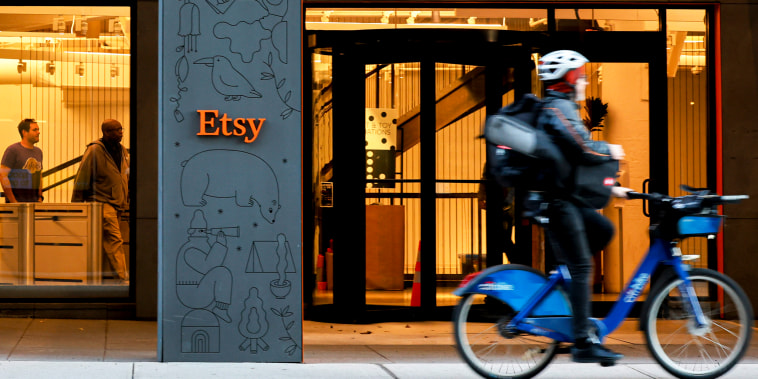When Etsy launched almost two decades ago, the site attracted artisans and craft makers, who finally had a place online where they could sell their niche products and reach a large audience. But in recent years, Etsy has found itself overrun with mass-produced, generic items from resellers who have learned how to game the website and crowd out handcrafted products.
Now Etsy CEO Josh Silverman wants the company, whose stated mission is to “keep commerce human,” to get back to its roots.
The company on Tuesday is launching a major overhaul of the policies that govern its site to make it “crystal clear” to shoppers what products belong on Etsy, Silverman said in an interview with CNBC. The changes include new labels on its website and app to show how each seller created a particular item.
“We’re positioning ourselves to answer the call for original goods and real people by dialing up the things that make Etsy, Etsy,” Silverman said.
Etsy is rolling out a new marketing campaign around the policy changes, including a TV spot that shows ceramicists, clothing makers and other artists, followed by a smashed robotic arm. The platform’s new rules require all items to incorporate “a human touch” as outlined by its creativity standards. Each product has to fall into one of four categories: made by a seller (either by hand or using automated tools), designed by a seller, handpicked by a seller, or sourced by a seller.
With the changes, Etsy is hoping it can keep buyers and sellers returning to its site at a time when e-commerce is increasingly being dominated by Amazon and upstarts like China-linked Temu and Shein, which provide shoppers with cheap goods delivered to their doorsteps in a few days. The stakes are huge, as eMarketer estimates the global e-commerce market is projected to cross $6 trillion this year.
“I feel like there’s a race to the bottom in terms of commoditized commerce right now and almost everyone in e-commerce is playing that race,” Silverman said. “They’re selling the exact same product and they’re trying to sell it to you for 2 cents cheaper, or ship it two hours faster.”
Etsy has struggled to navigate the changing market dynamics. In its most recent quarter, gross merchandise sales, or the dollar value of items sold in its marketplace, slumped 3.7% from the prior year to $3 billion. The stock has lost more than 80% of its value since peaking in late 2021. It’s down 32% in 2024, while the Nasdaq has gained 23% over that stretch and closed at a record on Monday.
In December, Etsy laid off 11% of its workforce, with Silverman citing the “very challenging macro and competitive environment” as reasons for the cuts.
The company is also dealing with pressure from activist Elliott Management, which has amassed a roughly 13% stake in the company, making it Etsy’s largest investor. In February, Elliott partner Marc Steinberg joined Etsy’s board.
The roller coaster started earlier. Etsy went public in 2015, forcing the company to start answering to shareholders’ demands for growth, a contrast to its feel-good, socially conscious culture.
Etsy’s business exploded during the pandemic, spurred by a flood of mask buyers. The stock price quadrupled in 2020, and the number of businesses selling goods on the site more than doubled to 9 million between 2020 and 2023.
Until now, Etsy has used its “house rules” to police the site. The key policy was that “everything listed for sale on Etsy must be handmade, vintage, or a craft supply.” Resellers were prohibited.
The new rules are more specific and updated to reflect today’s realities. For example, a 3D-printed sculpture is considered “made by a seller.” It’s forbidden for a seller to add a single sticker to a commercially available face mask and pass it off as handcrafted. Regarding artificial intelligence-generated content, the policies note that “seller-prompted AI art,” such as a dog dressed in regalia, qualifies as “designed by a seller,” but a digital download of “over 5000 ChatGPT prompts” isn’t allowed.
Etsy has for years been trying to balance preserving its image as a place for unique, handcrafted goods, with an effort to bolster the selection of items to compete with its bigger rivals. For early sellers like Ashley Smith, the changes haven’t always been welcome.
Smith began selling custom wedding handkerchiefs on Etsy through her business, The Polka Dotted Bee, in 2011. Smith said Etsy was then a place where you could “search endlessly for amazing things that people were making,” and has turned into a site increasingly dominated by generic goods.
One of Etsy’s biggest changes came in 2013, when the company allowed sellers to use production partners. Rather than making products themselves, sellers could turn to contract manufacturers for help with their products.
Abby Glassenberg applauded the move. Glassenberg, who opened her handmade stuffed animal shop on Etsy in 2005, said it meant she only needed to create a pattern once and could sell “infinite copies,” cutting down on her workload. Her Etsy shop went from being a hobby business to a full-time career, she said.
However, Glassenberg understands the tension, as many Etsy consumers still want the handcrafted experience.
“Handmade doesn’t scale,” she said. “That’s why we like it, that’s why human beings like it.”
Glassenberg gave the example of a crafted fork that’s been forged and cut by human hands.
“I’m going to pay $120 for it, and use it and love it forever,” she said. “There’s no way a person could make 100,000 of them a month, and that’s why we love it.”
Competing on a bigger stage is different though, and Smith said the mainstream preference for cheap and quick goods creates “an uphill battle for sellers and for Etsy.”
Temu and Shein have grown their presence in the U.S. in recent years, luring American shoppers with deep discounts on clothing, jewelry, home goods and other products. Silverman has previously acknowledged that the sites “are taking a little bit of share from everyone.”
He’s now making it clear to sellers and customers that the company will compete on its own terms.
“The solution to that for Etsy is not to try to play that game,” Silverman said.



























